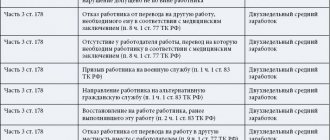Is compensation calculated for unused vacation upon dismissal in 2018?
In practice, situations often arise when an employee does not have time to take all the paid leave due to him under the Labor Code.
And if such an employee suddenly decides to leave the company, the question will arise: what to do with the unused part of the vacation? Should I take the remaining days off or can I receive monetary compensation for them? The Labor Code of the Russian Federation clearly answers: the employer must pay the former employee compensation for unpaid vacation upon dismissal, i.e. for each unused day.
https://youtu.be/ar5p_sDMLSA
IMPORTANT! An employee’s right to calculate compensation for unused vacation and its payment upon dismissal does not depend on the basis on which the employment contract was terminated (letter of Rostrud dated July 2, 2009 No. 1917-6-1).
After the organization is convinced of the need for payment, it faces the question: how to calculate compensation for unused vacation?
Example 5
A short-term employment contract was concluded with the employee to perform work from March 27 to May 5, 2009 inclusive. It is required to calculate the amount of compensation for unused vacation upon dismissal.
During the period from March 27 to May 5, 2009, 1 month and 8 days were worked. Since 8 calendar days are less than 15, they are not taken into account. Consequently, 1 month of work is counted towards the length of service giving the right to receive compensation for vacation.
Since a short-term employment contract has been concluded with the employee, the rules of Article 291 of the Labor Code of the Russian Federation apply. Compensation for unused vacation will be 2 working days.
If an employment contract is concluded with an employee for an indefinite period, but for some reason it is interrupted before the end of the two-month work period, the provisions of Article 291 of the Labor Code of the Russian Federation cannot be applied.
Who is entitled to dismissal compensation?
The rights and obligations of employed citizens are regulated by the Labor Code of the Russian Federation. In accordance with Art. 114 working people have the right to take annual paid leave.
The employee is entitled to 28 days of rest per year. Working year and calendar year are categories of different order: for an employee, the calculation is carried out from the date of employment.
• specialists who have not been on vacation during the entire period of work in the organization; • those who did not have time to take advantage of the vacation right in the last year of service; • at the end of the employment contract; • persons moving to another job in the same organization; • part-time employees working day; • employees of liquidated enterprises, as well as in case of job reduction.
The reason for dismissal does not matter: at one’s own request, by agreement of the parties, and even in case of inconsistency with the position held - all these are cases of assigning payments for unclaimed vacation.
The employee has no current salary. There may be several reasons, and therefore solutions. For example, a woman was on maternity leave or caring for a child. Then the payment of vacation pay upon dismissal is made from the salary of the position, taking into account allowances, bonuses and other additional payments. If we are talking about an unofficial salary “in an envelope,” then you should not count on compensation. According to the documents, the person was not charged.
Excessively paid vacation pay. Such misunderstandings are common. Depending on the time the error was detected, two options are possible:
- an error in accruals was discovered before dismissal. The benefit is recalculated;
- the truth emerged after the citizen’s calculation. The company's billing department specialists answer.
https://youtu.be/Am2Uf4jtlW0
Not taking vacations for several years. According to the law, the right to such vacations is not lost. The employer is obliged to compensate all unclaimed periods to any applicant: part-time workers, personnel on fixed-term employment contracts, employees who have not completed the probationary period, etc.
Rules for calculating vacation days
According to Article 127 of the Labor Code of the Russian Federation, on the final working day, a citizen is given a monetary compensation for a vacation on which he did not go. This rule applies to both main leave and additional leave. In organizations and institutions with a special work environment, the working team has the right to additional leave or several days in addition to the main one.
The reason and motive that prompted a person to leave his place of work does not affect compensation for vacation. But only if he has not committed any crime. In a situation where an employee has worked for less than a year, vacation days subject to monetary compensation are calculated in proportion to the months of work.
In real life, there are circumstances that prevent the payment of compensation. If an employee has not worked the days during which he managed to go on vacation, then the amount of vacation days that falls on the unworked portion of the vacation is subject to deduction from accrued but not paid wages.
When calculating, a coefficient of 2.33 days per month is taken. This number is the result of dividing the standard vacation of 28 days by 12 (the number of months in a year). To calculate compensation, you should follow the generally accepted procedure.
First, you need to calculate the number of vacation days not taken by the employee. Before doing this, you should find out:
- the entire period of employment in this company;
- periods subject to deduction from length of service, but providing the right to vacation;
- the total number of vacation days an employee is entitled to while working for the company;
- the number of all days of all employee vacations used by him while working in this company.
Article 121 of the Labor Code dictates the rules for calculating the entire length of service, the presence of which gives the right to annual leave.
She tells us to take into account:
- hours actually worked;
- days when the workplace was assigned to the employee (days of vacation, holidays, weekends);
- absenteeism and absences initiated by someone other than the employee in question;
- vacation without pay (no more than two weeks per year).
To establish the length of service that gives the right to leave, it is necessary to subtract from the total period of work of an employee in a particular organization the time excluded from the leave experience.
To calculate the average wage per day, the total real earnings received by the employee during the time period taken for calculation should be divided by 12, and then by 29.3 (the average monthly number of days).
The actual salary is all the payments that the worker received, and more specifically:
- salary;
- surcharges and allowances;
- payments related to special working conditions;
- remuneration and bonuses;
- other charges.
The concept of actual salary does not include payments:
- payment of travel costs, food, training;
- temporary disability benefits;
- material assistance;
- average earnings retained by the employee during business trips, vacation pay;
- maternity benefits;
- payment for downtime through no fault of the employee.
https://youtu.be/aHcjgG_YCWo
In accordance with the general rule, an employee who decides to leave the company has the right to receive monetary compensation for unused vacation in proportion to the total months worked in the company for which these days were accrued (clause 28 of the Vacation Rules, approved by the People's Commissariat of Labor of the USSR on April 30, 1930 No. 169, hereinafter referred to as the Rules).
However, if an employee decides to leave his previous place of work not of his own free will, but due to the occurrence of the circumstances listed in clause 28 of the Rules (for example, there was a reduction in staff), then the employer will have to pay him compensation in the amount of the full year worked , but only on condition that such an employee managed to work in the company from 5½ to 11 months (clause 28 of the Rules).
We invite you to read: Compensation for damage by an individual
IMPORTANT! The above rule applies only if the employee has not worked for the company for a whole year. Otherwise, upon dismissal, compensation for unused vacation will be calculated according to the general procedure, i.e., in proportion to the time worked.
Other employees (who left the company not due to circumstances specified in clause 28 of the Rules) can also count on full compensation (as for a whole year), but only if on the date of leaving the organization they managed to work for 11 months, but did not complete the full year.
Rcompens. = Number of unused days × SRdnZr,
where: Rcompens. — amount of compensation;
Number of non-users days — number of unused vacation days;
SRdnZr - employee’s earnings on average for 1 working day.
In order to determine the value of the SRdnZr, you need to have information about what salary was accrued to the employee who decided to leave the company during the last 12 months (before the dismissal). In addition, you should know exactly how many days out of these 12 months the employee actually performed work functions (clause 5 of the Decree of the Government of the Russian Federation “On the calculation of average wages” dated December 24, 2007 No. 922).
SRdnZr = ZP /12 × 29.3,
where: ZP is the salary that was accrued to the employee for the last 12 months;
29.3 is the average number of days in a month.
IMPORTANT! For the purpose of calculating the average salary per day, all payments received by the employee and provided for by the labor or collective agreement are taken into account. In this case, payments made outside the framework of labor relations (social benefits, financial assistance, etc.) are not taken into account (paragraphs 2, 3 of Resolution No. 922).
SRdnZr = ZP / K6-day. slave. weeks,
SRdnZr - employee’s earnings on average for 1 working day;
Salary - the salary that was accrued to the employee for the last 12 months;
K6-days slave. weeks = the number of days an employee has worked based on a 6-day workweek calendar.
IMPORTANT! If for the 12 months preceding the day of dismissal the employee was not paid a salary, then the average salary for 1 day will be determined on the basis of data on earnings accrued for the previous period of a similar length (clause 6 of Resolution No. 922).
The calculation method has not changed over the last year, so compensation for leave upon dismissal in 2020 should be calculated according to the above formulas and rules.
In order to correctly determine what amount in monetary terms should be reimbursed to an employee for not having time to take his entire allotted vacation, it is important to find out exactly how many days he has left. However, doing this in practice is not always easy.
First of all, you need to find out what the “vacation” length of service of the employee who decided to quit is. That is, for how many full months of performing his duties in the company he is entitled to the corresponding number of vacation days.
Rarely does anyone have an exact number of months worked at the time of dismissal. Much more often in practice, a different situation is common: on the day of dismissal, a month has not been fully worked. How to calculate compensation upon dismissal in this situation is described in paragraph 35 of the Rules:
- if more than half a month has been worked, you need to count such a month as a full month;
- if less than half a month is worked, such period is not taken into account.
IMPORTANT! For calculation purposes, a month is understood not as a separate calendar month, but as the month of actual performance of labor functions by an employee in a specific company from the moment he was hired by the company (for example, from June 16 to July 16).
After determining the “vacation” period, the accountant must calculate the number of days of unused vacation. How to calculate compensation upon dismissal depends on which days the employee’s vacation was accrued—calendar or working days.
If leave was granted in calendar days, then you need to proceed as follows.
For each month of work, the employee is accrued 2.33 days of vacation (letter of Rostrud dated October 31, 2008 No. 5921-TZ). Next, by multiplying the value of 2.33 and the “vacation” experience, the total number of vacation days is calculated. After this, those days that the employee has already taken off work before are subtracted from the total value.
https://youtu.be/gXAUMelo9as
This is discussed in more detail in the article “How to calculate the number of vacation days upon dismissal?”
IMPORTANT! The exception is those persons who managed to work in the company for more than 11 months, but decided to leave it without working for the company for a year. In such cases, the organization pays compensation in full annual amount, i.e., as if the entire year had been worked.
Number of non-users days = Number of months slave. × 2.33 – Disp.,
Number of months slave. — the number of months during which the employee was registered with the company;
Disp. — the number of vacation days used by the employee.
IMPORTANT! When calculating compensation, the days remaining from vacation must be rounded in favor of the employee (up), and not according to arithmetic rules. For example, an employee was hired by the organization on March 28, 2018, and left on June 5, 2018. In this case, the number of days of unused vacation is 4.66 calendar days (2.33 calendar days for the period from March 28, 2018 to April 27.
Let's look at how to calculate vacation compensation upon dismissal if an employment contract was concluded with the employee for the period of seasonal work. In this case, vacation is accrued according to the Labor Code of the Russian Federation in working days (Article 295). For 1 month of work, in this case, not 2.33 calendar days are required, but 2 working days of vacation (Article 139 of the Labor Code of the Russian Federation).
Formula for calculating days and amount of compensation
1. We distribute the vacation allotted for the year monthly: vacation days per 1 working month = vacation for the year according to the staffing schedule: 12 (months)
2. calculate unused periods: number of unused vacation days = vacation per working month X months worked, vacation days used
Months worked incompletely are taken into account according to rounding rules. A person has worked for more than a month - the full period is counted; work for less than half a month - days are not counted.
We invite you to familiarize yourself with: Internal memorandum of dismissal for drunkenness of the Labor Code of the Russian Federation
Employees with many years of service need to know that upon dismissal, unused days are taken into account and vacation pay is paid for the entire period of work in the company, and not just for the last year.
Then the calculation should be carried out using the following formula:
- KNDo = OOG X PDOg oIDO
- KNDo - the number of unused days of rest,
- OOG – total years worked,
- PDOg - allotted vacation days per year,
- oIDO – total vacation days used for the entire period.
If the employee did not use the next vacation, compensation is accrued for 28 days; if the period for which vacation pay is supposed to be accrued is less than a year, then the number of days of vacation due is calculated proportionally.
For example: an employee has not used vacation for 6 months 18 days. Let's determine the number of paid days using the formula: Number of days = 28: 12 ˟ 7 = 16.31 days, where 28 is the number of days of regular vacation per year, 12 is months in a year; 7 is the number of months of unused vacation.
To determine the number of months, arithmetic rules are used when rounding days. More than half a month in the example is rounded up to the full month, and vice versa, less is discarded.
OT annual – accrued wages for the last 12 months, 12 – number of months in a year, 29.3 – average monthly number of calendar days accepted for official calculations.
Not all payments are included in salary for calculating compensation or vacation pay.
Thus, payments are not taken into account if the employee:
- worked while maintaining average earnings (business trip, production needs, etc.);
- received payments for sick leave due to illness or pregnancy and childbirth;
- did not work due to various reasons through no fault of his own. The accrual of compensation payments is calculated using the formula:
Amount of compensation payments = average daily earnings ˟ number of vacation days.
In this case, the reasons for the situation should be considered. If the employee received average monthly earnings for the last year (this happens during long business trips, after maternity leave or parental leave), then the calculation is made from the salary, taking into account all types of accruals and bonuses accepted by the tariff agreement approved at the enterprise.
If wages were paid at the enterprise according to the so-called gray schemes, and were not documented, then there can be no question of officially calculating the rest of the vacation.
Particular care should be taken when calculating vacation pay followed by dismissal. Practice shows that it is in these cases that a large number of mistakes are made.
But if compensation is calculated incorrectly due to an error by company personnel (HR or accountant) and this is later discovered, the guilty parties are subject to penalties.
The period of time worked is of no small importance:
- more than 11 months - employee compensation is calculated for every full 11 months.
- up to 1 month - compensation payments will be accrued if the employee has worked for more than half a month. In this case, unused vacation days are calculated as one full month.
- from 1 to 11 months. An employee who has worked for 11 months has the right to a full payment of compensation. If the duration of work varies from 1 to 11 months, a proportional calculation is made.
There are exceptions - according to the adopted Rules of April 30, 1930 N 169, employees who have worked from 5.5 to 11 months are awarded compensation payments in full if the reason for dismissal was:
- liquidation of the enterprise;
- entry into military service;
- transfer to another job and in some other cases.
https://youtu.be/Ys1o1IYZTTk
HR officers and company managers usually do not welcome the desire of employees to ignore the next vacation, but sometimes it happens that unused vacations are collected over several years. The employer's claims that the right to previous vacations have been lost are unfounded.
It is established by law that compensation must be paid for all unused vacations of absolutely all employees. It does not matter whether they work under a fixed-term employment contract, are on a probationary period, or are external part-time workers.
For unused additional leave, established in addition to the main one by accepted tariff agreements, in many companies compensation is calculated according to the general rule and is not divided into main and additional.
For example,
- if the company has established an additional leave of 5 days for employees of certain positions, then the calculation period for compensation will be considered 33 days (28 5);
- if there was a vacation at your own expense within 14 days, then compensation is calculated based on the time worked 14;
- If the leave without pay is more than 14 days, then compensation is calculated for fewer days, since they are excluded from the calendar number of days of the month on which they fall.
Calculation of unused vacation days
Number of non-users days = Number of months slave. × 2 – Disp.
As a general rule, the company must calculate compensation for unused vacation upon dismissal and pay it to the resigning employee on his last day of work (Article 140 of the Labor Code of the Russian Federation).
IMPORTANT! If the resigning employee for any reason was not at work on his last working day, the company is obliged to pay all amounts due no later than the next day after the dismissed employee submitted a request for payment.
Therefore, on the last working day, an employee who decides to leave his place of work must receive compensation from the company for unpaid vacation.
Compensation for unpaid leave can be documented using a form developed by the employer independently, or unified form No. T-61.
For more information about form No. T-61, see the article “Unified form No. T-61 - form and sample.”
https://youtu.be/YirfYiSzbzA
Wed/daily OT = Annual OT 12 29.3
- Wed/day FROM – Wed. wages for workers day;
- annual OT – annual salary for the last year;
- 29.3 – official Wed. number of calendar days in a month.
The law provides for payments that are not included in the accrual of vacation pay upon dismissal:
- periods of work paid at the average rate: business trips, employer initiative;
- b/sheets for illness, maternity leave.
Compensation = Average/daily earnings X Number of unused days
- seasonal specialists (Article 295);
- employees on short-term agreements (Article 291).
Number of unused days = Months actually worked at the enterprise x 2 working days – Number of vacation days used at the place of dismissal
How is vacation compensation calculated in this case? The algorithm is the same as for employees with calendar exemption from service.
We invite you to read: Will the service life be increased to 25 years in the UIS?
If it is discovered that the administration saved vacation pay when dismissing an employee, the company will have to answer administratively:
- a legal entity is subject to a fine of 30–50 thousand rubles;
- officials of organizations are fined in the amount of 10-20 thousand rubles;
- and from a thousand to 5 thousand will be paid by individual entrepreneurs.
Although employers do not violate the law so openly. Delays in issuing payments are more common. But even here the law protects the interests of citizens: in case of disputes, the employer is obliged to supplement the compensation by charging interest at the rate of the Central Bank.
Take into account every year of vacation not taken by the employee or partially taken off. Note: we are talking about the working year here. Do the calculation for every twelve working months, starting from the date the person was hired.
However, do not include during this period:
- time away from work without good reason;
- maternity leave for up to 3 years;
- vacation without pay for more than 14 calendar days.
A full month worked will be considered a period of half a month or more. Exclude periods of less than half a month from the calculation.
Please note: in some cases, the employee must be paid compensation for the entire year of work, even if he worked for a shorter period. Do this when the person has worked for at least 10.5 months. After all, full compensation is due for 11 months.
Also pay the full annual amount of compensation for an actual period of work from 5.5 to 11 months, if the employee leaves due to:
- staff reductions;
- liquidation of the company;
- conscription into the army;
- recognition based on a medical report as incapable of work.
Apply full compensation rules to all categories of employees who have served 5.5 months or more of annual leave entitlement.
The following information is required to be filled out in the order:
- on the number of days of the next unused vacation;
- about excessively used and subject to withholding vacation days;
- Articles of the Labor Code when issuing a dismissal order - 114,121,127,137 require strict compliance with the requirements contained therein.
Calculation example No. 2. Employee Ivanov quits on March 25, 2019. The last time he was on vacation was from December 1 to December 28, 2011, i.e. the vacation was not used for more than 2 years. The accounting year is from March 1, 2013 to February 28, 2020.
Let's determine the quantity:
- months of unused vacation for 2012 - 12 months, 2013 - 12 months, for 2020 - 2 months 25 days 26 months 25 days = 27 months;
- days of compensation due – 28:12˟27= 63 days
Average daily earnings = (18,000 ˟ 4) (20,000 ˟: 12: 29.3 = 659.84 rubles Amount of compensation = 659.84 ˟ 63 = 41,569.92 rubles Calculate personal income tax 41,569.92 ˟ 13: 100 = 5,404.09 rubles Amount in hand = 41569 .92 – 5404.09 = 36165.83 rubles.
When issuing it in person, you should take into account all deductions paid by the employee. For example, alimony is collected from all types of income, therefore, from compensation too.
So, the procedure for calculating compensation payments is very simple, but it requires care and adherence to the correct calculation algorithm.
What does severance compensation mean?
When talking about compensation for leave upon dismissal, we usually mean its most general case, which applies to absolutely all employees. This is compensation upon dismissal in the form of vacation pay due for vacation not used during the period of work. Every employee has the right to annual paid leave, and at the time of dismissal, part of it (and sometimes even several years of leave) may be unused. Art. 127 of the Labor Code of the Russian Federation obliges to pay this part in case of dismissal, no matter what its actual duration turns out to be. The reason for termination of the employment contract does not matter when calculating compensation upon dismissal.
How to calculate days of compensation upon dismissal? The duration of standard annual leave is 28 calendar days (Article 115 of the Tax Code of the Russian Federation). However, for some categories of workers it is extended (Articles 116–119, Article 348.10 of the Labor Code of the Russian Federation). Vacation pay upon dismissal is calculated based on the length of vacation that is due to a particular person, taking into account the extension, if any. Holidays do not include holidays.
The beginning of the year to which the annual leave will relate is determined individually by each employer for each specific employee - from the first day of his employment for this job (clause 1 of the Rules on regular and additional leaves, approved by the People's Commissar of the USSR on April 30, 1930 No. 169), and the end may be shifted if, during the calendar year calculated from the starting date, the employee experienced periods that were not included in this length of service (Article 121 of the Labor Code of the Russian Federation).
Calculation of compensation upon dismissal in 2020 is also carried out for persons signed under a fixed-term (up to 2 months) employment contract (Article 291 of the Labor Code of the Russian Federation) or for part-time work (Article 93 of the Labor Code of the Russian Federation). For a fixed-term contract, vacation pay is calculated based on the fact that each month worked corresponds to 2 working days of vacation.
There is no need to accrue compensation for unused vacation upon dismissal to employees:
- drawn up under a GPC agreement (Article 11 of the Labor Code of the Russian Federation);
- those who worked less than half a month (clause 35 of the Rules on regular and additional leaves, approved by the People's Commissariat of Labor of the USSR on April 30, 1930 No. 169).
The accrued compensation upon dismissal is subject to insurance premiums, personal income tax and is paid along with other amounts due to the employee on the last day of his work activity (Article 140 of the Labor Code of the Russian Federation).
ConsultantPlus experts have made an analytical selection on legal disputes with employees regarding the payment of dismissal compensation.
Get trial access to the system and find out court decisions on the most common questions.
Read about whether it is possible to receive vacation pay compensation without resorting to dismissal.
The nuances of assigning dismissal compensation
The amount of compensation directly depends on the period of work since the end of the last annual leave:
- less than 1 month – payment for unused vacation is made only if the employee has worked for 15 days or more. Then this period is conventionally taken as a fully worked month;
- 1-11 months – payment is proportional to the number of periods worked. If you have 11 months of work experience, you are entitled to full compensation for leave upon dismissal.
In this order, there are exceptional situations inherited from the Soviet period. They are defined by Regulations No. 169 of 1930. The company provides full compensation for a working period of 5.5 to 11 months. Dismissal occurs due to force majeure circumstances:
- liquidation of the organization;
- conscription for compulsory military service;
- assignment to another area of work at the suggestion of the administration;
- other grounds for this category.
Terms of payment of compensation
It is very important to know the timing of payment of compensation. By law, management is required to make final payments to an employee on his last working day. This calculation should also include compensation for leave, if the employee did not write an application for leave with subsequent dismissal in exchange for compensation.
If an employee is absent from work for any reason on his last day of work, payment must be made to him:
- If possible, by transferring funds to a bank account;
- When issuing money in cash, no later than the next day after the employee’s request.
What to do with unused additional leave?
IMPORTANT! Such leave is provided to the employee under a collective agreement. For example, a collective agreement may stipulate that upon reaching a certain length of service in the company, an additional few days of vacation are granted.
In such a situation, it is important to remember that days of additional leave must be compensated in accordance with the general procedure (described above), i.e., as if these were days of regular annual leave. This conclusion follows from Art. 127 of the Labor Code of the Russian Federation, which states that when an employee is dismissed, the employer must compensate him (in monetary terms) for all unused vacations.
Therefore, when calculating compensation for unused vacation upon dismissal in 2020, it is important to strictly follow the general procedure described above.
We described in detail about compensation for unused vacation without dismissal here.
In addition to compensation for missed vacation, the employer is obliged to pay the employee wages. Find out how to calculate it correctly here.
Labor legislation has not established an exact algorithm, so enterprise accountants use established practice. General and preferential days are added up, accrual occurs according to the general procedure:
- with an additional 7 days of rest, compensation extends to 35 days (28 7);
- if the benefit is 14 days, then these two weeks will be added to the calculated vacation.
Limitation. To calculate compensation for unused vacation time, a period exceeding 14 days cannot be used.
https://youtu.be/hlw_UtoEo2E
Example 6
An employment contract for an indefinite period was concluded with the employee on November 2, 2009. The employee resigns of his own free will on December 14, 2009. It is required to calculate the number of calendar days of compensation for unused vacation upon dismissal.
The duration of work in the organization was 1 month and 12 days. Vacation compensation is due to any employee who has worked for more than 15 calendar days.
The contract with the employee was concluded for an indefinite period, therefore the rules established by Article 291 of the Labor Code of the Russian Federation for employees with whom a contract was concluded for a period of up to two months cannot be applied. The amount of compensation is determined based on the generally established vacation duration of 28 calendar days. The length of service giving the right to leave is 1 month. Therefore, the employee is entitled to compensation in the amount of 28 days / 12 months. x 1 month = 2.33 days
In educational budgetary organizations, teachers and professors who resign after 10 months of the academic year have the right to receive compensation for the full duration of vacation of 56 calendar days. If a teacher resigns during the academic year, he is entitled to proportional compensation at the rate of 4.67 days for each month worked.











